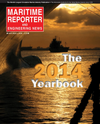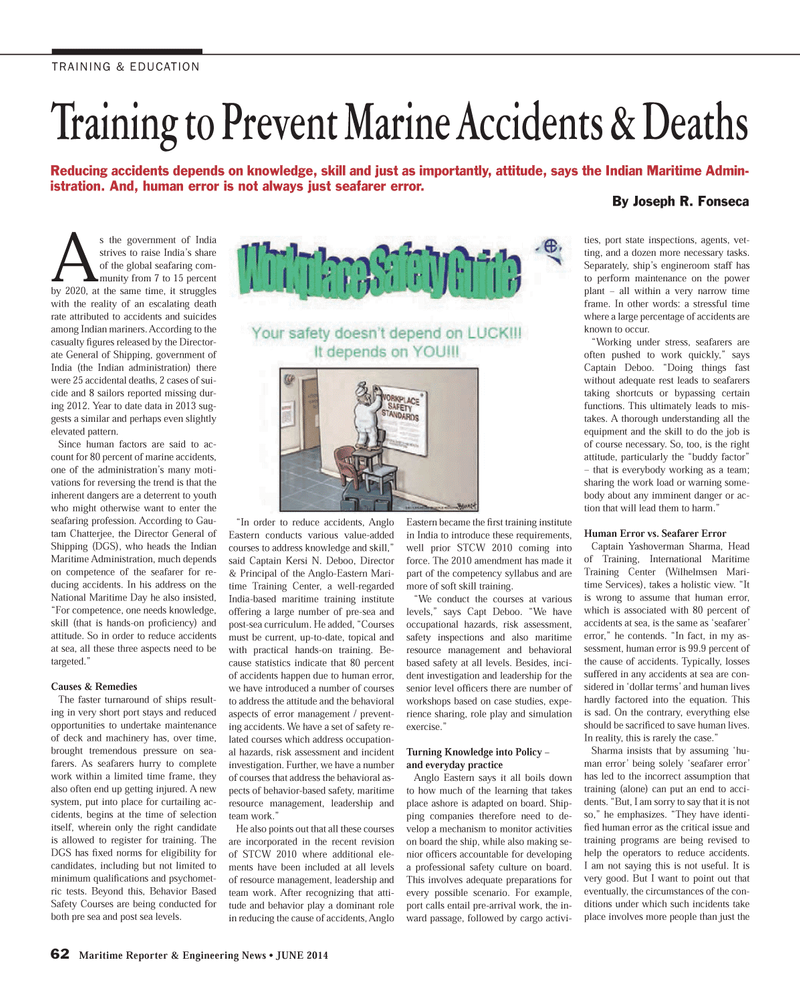
Page 62: of Maritime Reporter Magazine (June 2014)
Annual World Yearbook
Read this page in Pdf, Flash or Html5 edition of June 2014 Maritime Reporter Magazine
62 Maritime Reporter & Engineering News • JUNE 2014
A s the government of India strives to raise India’s share of the global seafaring com- munity from 7 to 15 percent by 2020, at the same time, it struggles with the reality of an escalating death rate attributed to accidents and suicides among Indian mariners. According to the casualty ? gures released by the Director- ate General of Shipping, government of
India (the Indian administration) there were 25 accidental deaths, 2 cases of sui- cide and 8 sailors reported missing dur- ing 2012. Year to date data in 2013 sug- gests a similar and perhaps even slightly elevated pattern.
Since human factors are said to ac- count for 80 percent of marine accidents, one of the administration’s many moti- vations for reversing the trend is that the inherent dangers are a deterrent to youth who might otherwise want to enter the seafaring profession. According to Gau- tam Chatterjee, the Director General of
Shipping (DGS), who heads the Indian
Maritime Administration, much depends on competence of the seafarer for re- ducing accidents. In his address on the
National Maritime Day he also insisted, “For competence, one needs knowledge, skill (that is hands-on pro? ciency) and attitude. So in order to reduce accidents at sea, all these three aspects need to be targeted.”
Causes & Remedies
The faster turnaround of ships result- ing in very short port stays and reduced opportunities to undertake maintenance of deck and machinery has, over time, brought tremendous pressure on sea- farers. As seafarers hurry to complete work within a limited time frame, they also often end up getting injured. A new system, put into place for curtailing ac- cidents, begins at the time of selection itself, wherein only the right candidate is allowed to register for training. The
DGS has ? xed norms for eligibility for candidates, including but not limited to minimum quali? cations and psychomet- ric tests. Beyond this, Behavior Based
Safety Courses are being conducted for both pre sea and post sea levels. “In order to reduce accidents, Anglo
Eastern conducts various value-added courses to address knowledge and skill,” said Captain Kersi N. Deboo, Director & Principal of the Anglo-Eastern Mari- time Training Center, a well-regarded
India-based maritime training institute offering a large number of pre-sea and post-sea curriculum. He added, “Courses must be current, up-to-date, topical and with practical hands-on training. Be- cause statistics indicate that 80 percent of accidents happen due to human error, we have introduced a number of courses to address the attitude and the behavioral aspects of error management / prevent- ing accidents. We have a set of safety re- lated courses which address occupation- al hazards, risk assessment and incident investigation. Further, we have a number of courses that address the behavioral as- pects of behavior-based safety, maritime resource management, leadership and team work.”
He also points out that all these courses are incorporated in the recent revision of STCW 2010 where additional ele- ments have been included at all levels of resource management, leadership and team work. After recognizing that atti- tude and behavior play a dominant role in reducing the cause of accidents, Anglo
Eastern became the ? rst training institute in India to introduce these requirements, well prior STCW 2010 coming into force. The 2010 amendment has made it part of the competency syllabus and are more of soft skill training. “We conduct the courses at various levels,” says Capt Deboo. “We have occupational hazards, risk assessment, safety inspections and also maritime resource management and behavioral based safety at all levels. Besides, inci- dent investigation and leadership for the senior level of? cers there are number of workshops based on case studies, expe- rience sharing, role play and simulation exercise.”
Turning Knowledge into Policy – and everyday practice
Anglo Eastern says it all boils down to how much of the learning that takes place ashore is adapted on board. Ship- ping companies therefore need to de- velop a mechanism to monitor activities on board the ship, while also making se- nior of? cers accountable for developing a professional safety culture on board.
This involves adequate preparations for every possible scenario. For example, port calls entail pre-arrival work, the in- ward passage, followed by cargo activi- ties, port state inspections, agents, vet- ting, and a dozen more necessary tasks.
Separately, ship’s engineroom staff has to perform maintenance on the power plant – all within a very narrow time frame. In other words: a stressful time where a large percentage of accidents are known to occur. “Working under stress, seafarers are often pushed to work quickly,” says
Captain Deboo. “Doing things fast without adequate rest leads to seafarers taking shortcuts or bypassing certain functions. This ultimately leads to mis- takes. A thorough understanding all the equipment and the skill to do the job is of course necessary. So, too, is the right attitude, particularly the “buddy factor” – that is everybody working as a team; sharing the work load or warning some- body about any imminent danger or ac- tion that will lead them to harm.”
Human Error vs. Seafarer Error
Captain Yashoverman Sharma, Head of Training, International Maritime
Training Center (Wilhelmsen Mari- time Services), takes a holistic view. “It is wrong to assume that human error, which is associated with 80 percent of accidents at sea, is the same as ‘seafarer’ error,” he contends. “In fact, in my as- sessment, human error is 99.9 percent of the cause of accidents. Typically, losses suffered in any accidents at sea are con- sidered in ‘dollar terms’ and human lives hardly factored into the equation. This is sad. On the contrary, everything else should be sacri? ced to save human lives.
In reality, this is rarely the case.”
Sharma insists that by assuming ‘hu- man error’ being solely ‘seafarer error’ has led to the incorrect assumption that training (alone) can put an end to acci- dents. “But, I am sorry to say that it is not so,” he emphasizes. “They have identi- ? ed human error as the critical issue and training programs are being revised to help the operators to reduce accidents.
I am not saying this is not useful. It is very good. But I want to point out that eventually, the circumstances of the con- ditions under which such incidents take place involves more people than just the
TRAINING & EDUCATION
Training to Prevent Marine Accidents & Deaths
Reducing accidents depends on knowledge, skill and just as importantly, attitude, says the Indian Maritime Admin- istration. And, human error is not always just seafarer error.
By Joseph R. Fonseca
MR #6 (58-65).indd 62 6/10/2014 10:38:13 AM

 61
61

 63
63
